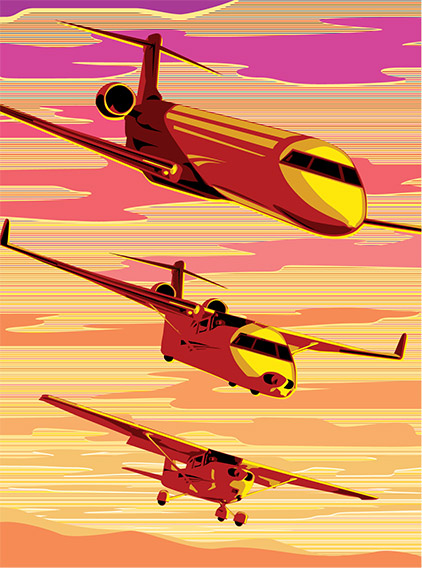 I will never forget my first takeoff in a Cessna 152. It was an amazing feeling. I experienced the same feeling seven years later when I rolled down the runway in a jet for the first time.
I will never forget my first takeoff in a Cessna 152. It was an amazing feeling. I experienced the same feeling seven years later when I rolled down the runway in a jet for the first time.
The speeds were nearly triple what I was used to, and the aircraft was 40 times heavier than the aircraft I was accustomed to flying. And yet, the rudder pedals still moved the airplane left and right, the yoke still pulled up the nose, and the ailerons still kept the airplane level. I found it funny how these two different machines handled in a similar manner while performing completely different roles.
Making the transition to a large aircraft can be a daunting proposition. Understanding some of the similarities and differences between piloting a large jet compared to a light piston airplane may help ease some of those large-jet jitters.
Takeoff
The Bombardier CRJ (for Canadair Regional Jet) is actually easier to control on the takeoff roll than a small single-engine aircraft. A 75,000-pound aircraft doesn’t get thrown around much and requires little rudder input to track the centerline. Because left-turning tendencies such as p-factor and torque are generally nonexistent in turbofan engines, there is no need to add extra rudder pressure to correct on the roll.
Crosswind correction on takeoff is type-dependent on jets. On the CRJ, yoke deflection is much less than for a piston Cessna. On light aircraft, you usually position the ailerons full into the crosswind and roll the correction out as the airspeed builds on takeoff. This amount of deflection on the CRJ would cause the
multifunction spoilers to deploy, inducing a yaw. This limits the amount you can turn the yoke to correct for crosswind.
Rotation takes about seven seconds from the time you start pulling back on the yoke for the CRJ to reach its climb attitude. This is appreciably longer than on light aircraft. One-handed fingertip flying is not effective in controlling the aircraft; the CRJ’s fight controls are powered hydraulically, and artificial control feel is produced by the flight control system to give the sensation of aerodynamic feedback. The feedback seems a bit excessive, but it prevents you from overcontrolling the aircraft. The best way to control the rotation is with two hands. The climb attitude is high, around 16 degrees.
Turns and maneuvering
The jet’s roll rate is nearly identical to that of a Cessna 172, but the artificial inputs from the flight control system require far more yoke pressure to turn than a light airplane, making the roll rate feel less than it is. Most turns require either a full single-handed grip on the yoke or a two-handed grip. Rudder is not needed. The aircraft’s yaw damper automatically adds rudder in turns, negating the need for rudder—except for crosswind landings and engine failures.
Pitch stability is nearly identical to that of a light aircraft. Holding altitude within 100 feet requires nearly the same amount of input in the jet as it does in a light twin, and requires slightly fewer inputs than a Cessna piston single. Of course, as altitude increases, it becomes more difficult to hold altitude without the autopilot.
Climbs and descents
Climb power on the CRJ is set by moving the thrust levers into a detent. The full authority digital engine controls then calculate and maintain climb power as altitude increases. This means the pilot does not have to make throttle adjustments in the climb. Leveling off from a climb is more difficult in the jet because of the higher climb rates. At 2,200 fpm it is harder to estimate when to start bringing the nose over, especially without causing undue stress to the passengers in the back.
The CRJ is more slippery than a piston Cessna and can be difficult to slow down. Luckily, the jet has spoilers to help. A normal descent ranges from 1,000 fpm to 2,300 fpm. Sometimes, higher descent rates are needed to make altitude restrictions; 2,500-fpm to 3,000-fpm descents can be done relatively comfortably with the use of spoilers. Leveling off from a high-rate descent is difficult without a flight director.
Approach and landing
Landing the jet is strikingly similar to landing a Cessna 152. I would wager that someone who is comfortable in a light aircraft could land the jet without breaking it after hand flying it for a bit. The approach speed is obviously higher on the jet—around 145 knots—but isn’t significantly faster than a light twin. Because the jet is more stable than a light aircraft, fewer pitch and power adjustments are required on final. The jet is less maneuverable than a small airplane, however. If you are not perfectly lined up with the centerline by 300 feet above the runway, making the runway would be difficult.
Although the flare occurs about four times higher on the jet, the attitude on landing is fairly flat and is nearly identical to that of a Piper Seneca. Pulling back in the flare as with a Skyhawk is a bad idea. Once the airspeed decays, the mains eventually will touch. After contact, some back-pressure on the yoke is needed to ease the nose onto the runway. Failure to do this will cause the nose to slam. Remember that the mains and the nose are separated by a considerable distance.
At the end of the day, large jets are flown using techniques remarkably similar to light-aircraft flying. The differences are easy to overcome. Once you get the hang of flying a jet, you will find that it’s much easier than flying a Skyhawk.
Michael Soroka is an airline pilot and A&P.
Illustration by Daniel Hertzberg


